Unit 1 Biology QCE 2025
1/74
Name | Mastery | Learn | Test | Matching | Spaced |
|---|
No study sessions yet.
75 Terms
State the cell theory
Cells are the basic structural units of living thing organisms. The cell theory states that all organisms are composed of cells, all cells come from pre-existing cells (biogenesis) and the cell is the smallest living organizational unit.
What defines a prokaryotic cell
Unicellular, lacks a nucleus, no membrane bound organelles and smaller in size. E.g., Bacteria and archaea. Many also have a flagella, pili, plasmids and a polysaccharide capsule.
What defines a eukaryotic cell?
Nucleus present, membrane-bound organelles, larger and more complex, mitosis and meiosis and DNA is linear. E.g., animals, plants fungi and protists.
What similarities do both prokaryotic and eukaryotic cells have?
Both cell types have a plasma membrane (lipid bilayer that surrounds the cell), cytoplasm, ribosomes and DNA.
Contrast eukaryotic and prokaryotic cells
Eukaryotic cells have a nucleus and membrane-bound organelles, while prokaryotic cells don't. Eukaryotes are larger and more complex, with linear DNA, while prokaryotes are smaller and simpler, with circular DNA.
What are the six kingdoms?
Bacteria, archaea, Protista, plantae, fungi and animalia
Define Unicellular
Unicellular means consisting of a single cell.
Think of it like this: "uni" means one, and "cellular" means related to cells. So, unicellular organisms are those made up of only one cell.
Define multicellular
Multicellular organisms are living things made up of many cells.
These cells work together, performing specialized functions to keep the organism alive and thriving. Think of animals, plants, and fungi—they're all multicellular
True or false Prokaryotic cells are multi and unicellular.
False. Prokaryotes are only unicellular and eukaryotes are unicellular and multicellular
What is the function of the nucleus?
The control center of the cell, containing the cell’s DNA.
What is the function of the mitochondria?
Converts chemical energy from food into energy that can be used by the cell. “powerhouse of the cell”
What is the function of the Rough endoplasmic reticulum?
Studded with ribosomes, it synthesizes proteins and phospholipids
What is the function of the ribosomes?
They make proteins and they’re thought of factories, either free-floating in the cytoplasm or attached to the Rough ER.
What is the function of the Smooth ER?
Synthesizes lipids, steroid hormones, carbohydrates, detoxifies and acts as calcium storage.
What is the function of the Golgi apparatus?
Modifies, sorts and packages proteins and other materials made in the ER for storage in the cell or secretion from the cell.
What is the function of the lysosomes?
Considered the clean-up crew. They’re membrane - bound sacks filled with enzymes that break down lipids, carbohydrates and proteins from food into smaller molecules that the cell can use
What is the function of vacuoles?
Storage container for water, food, enzymes, wastes, pigments, etc.
What is the function of chloroplast?
Found in plant cells, they are responsible for photosynthesis, converting light energy into chemical energy.
Identify the shape of each cell.
Animal cell: Often roundish or irregular like a blob with bumps. They don’t have a rigid cell wall, therefore, they’re more flexible.
Plant cell: Usually more rectangular or box-like due to the cell wall which gives them a more defined shape.
Bacteria: Kind of cylindrical shaped with tails and little fur bits.
Point out differences between organelles in the plant and animal cell
Plant cells have a cell wall, chloroplast and large vacuole whereas animal cells, lack that but have lysosomes.
What’s the difference between an animal cell and a bacteria cell.
Animal cells are eukaryotic, have membrane-bound organelles and are multicellular. Bacteria cells are prokaryotic and have no membrane-bound organelles, they also lack a nucleus.
Define the different proteins in the cell membrane and their function (or role/job)
Channel proteins: membrane proteins that form pores (in the phospholipid bilayer) to allow specific molecules or ions to pass through passively without using energy.
Carrier proteins: membrane proteins that transport specific molecules across the cell membrane by changing shape, either passively (facilitated diffusion) or actively (using ATP).
Summarise what the fluid Mosaic Model is?
Describes the structure of membranes, it suggests that the membranes are a flexible layer mainly composed of lipid molecules. This set up allows proteins to float within the membrane.
Define Channel Proteins
Allow specific molecules/ions to pass through (e.g., aquaporins for water).
Define carrier proteins
Bind and transport substances across the membrane (e.g., glucose transporters).
Define Glycoproteins
Proteins with carbohydrate chains that help with cell recognition and immune response.
Membrane-bound proteins may have carbohydrates attached. Explain the role these proteins play in the cell membrane.
Membrane-bound proteins with carbohydrates attached (glycoproteins) act like identification tags and communication tools on the cell surface. They help cells recognize each other, stick together, and respond to signals.
You are asked to give a one-minute summary to the class on the fluid mosaic model of the cell membrane. Consider the key points necessary for your response and organize them appropriately to clearly explain the fluid mosaic model to your class.
Describes the structure of the cell membrane as a flexible, dynamic barrier. It consists of a phospholipid bilayer, where the hydrophobic tails face inward, and the hydrophilic heads face outward, creating a semi-permeable membrane. Within this bilayer, proteins are embedded—some span the membrane (integral proteins) for transport, while others attach to the surface (peripheral proteins) for signaling and support. Glycoproteins and glycolipids aid in cell recognition, and cholesterol maintains fluidity and stability. The term "fluid" refers to the constant movement of phospholipids and proteins, while "mosaic" highlights the diverse components. This structure allows for selective transport, communication, and flexibility, essential for cell function.
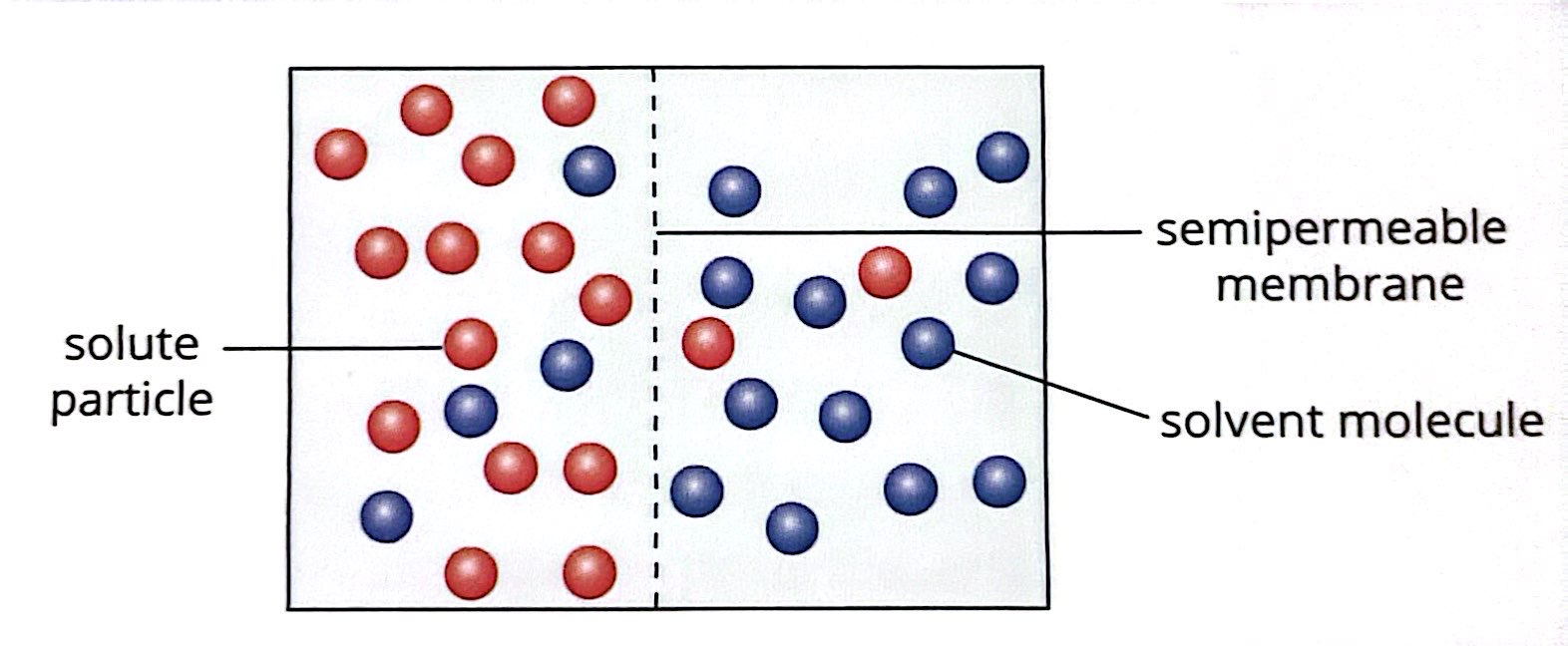
Two solutions are separated by a semipermeable membrane as illustrated below.
his image represents osmosis, the movement of solvent molecules (blue) across a semipermeable membrane from a region of low solute concentration (right side) to a region of high solute concentration (left side). Since the membrane is semipermeable, it allows only the solvent molecules to pass through while blocking the solute particles (red). This process continues until equilibrium is reached, where the concentration of solute on both sides is more balanced.
Two different solutions with the same volume are placed on either side of the semipermeable membrane in a U-shaped glass tube. The membrane is permeable to salt but not glucose. The tube is then left for a couple of days. Predict what happen to the:
a) salt concentration on each side of the membrane.
b) glucose concentration on each side of the membrane.
c) fluid levels on each side of the membrane
a) salt concentration on each side of the membrane.
Since the membrane is permeable to salt, salt molecules will diffuse across the membrane from the side with higher salt concentration to the side with lower salt concentration. Eventually, the salt will reach equilibrium, meaning the concentration of salt will be equal on both sides.
b) glucose concentration on each side of the membrane
The membrane is not permeable to glucose, so glucose molecules cannot move across the membrane. The glucose concentration on each side will remain the same as it was initially.
c) fluid levels on each side of the membrane
Since glucose cannot move, but water can, osmosis will occur. Water will move from the side with lower glucose concentration to the side with higher glucose concentration to try to balance the solute concentration. As a result, the fluid level will rise on the side with more glucose and decrease on the other side.
Define ‘semi permeability’
Semipermeability refers to the ability of a membrane to allow certain substances to pass through while blocking others. In biological systems, a semipermeable membrane, like the cell membrane, permits the movement of small molecules (e.g., water, gases, ions) but restricts larger molecules (e.g., proteins, glucose) unless transported by specific proteins. This property is crucial for osmosis, diffusion, and cell homeostasis.
List the factors that increase the rate of diffusion.
Higher Temperature
Steeper Concentration Gradient
Smaller Molecule Size
Higher Surface Area
Shorter Diffusion Distance
Increased Membrane Permeability
Osmosis is a special kind of diffusion. Define osmosis. Draw a diagram to illustrate your answer.
Osmosis is the movement of water molecules across a semipermeable membrane from an area of low solute concentration (high water potential) to an area of high solute concentration (low water potential), aiming to balance solute levels on both sides. This process is crucial in biological systems, such as plant cells absorbing water and kidney function in humans.
Explain how active transport is different from diffusion.
Active transport is the process where a cell moves substances against their concentration gradient, meaning from an area of lower concentration to an area of higher concentration. This requires the cell to expend energy, typically in the form of ATP whereas diffusion is movement from high to low concentration, no energy needed

Consider the red blood cells in the illustrations below. The arrows indicate the net diffusion of water movement. Applying your understanding of osmosis, describe how red blood cells would:
a) shrink
b) swell and burst
a) shrink
When a red blood cell is placed in a concentrated solution (a hypertonic environment), the concentration of solutes (dissolved substances) is higher outside the cell than inside. Therefore, the water concentration is lower outside the cell. By osmosis, water moves from an area of higher water concentration (inside the cell) to an area of lower water concentration (outside the cell).
b) swell and burst
When a red blood cell is placed in fresh water (a hypotonic environment), the concentration of solutes is lower outside the cell than inside. This means the water concentration is higher outside the cell. By osmosis, water moves from an area of higher water concentration (outside the cell) to an area of lower water concentration (inside the cell). Cells will burst if it takes in too much water.
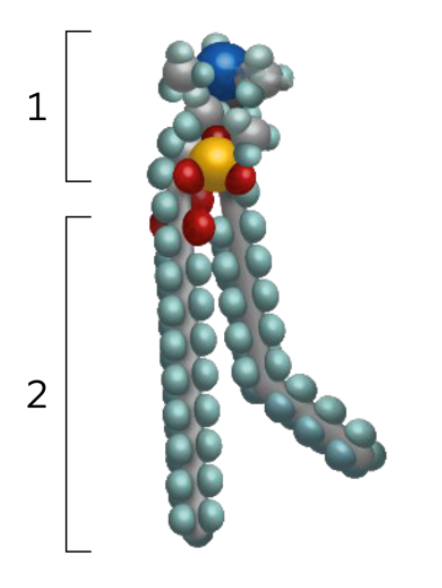
The image represents a phospholipid. Which of the following statements about the diagram is true?
a) Region 1 is hydrophilic.
b) Region 2 contains phosphate.
c) Region 1 is a fatty acid.
d) Region 2 is polar.
a) Region 1 is hydrophilic
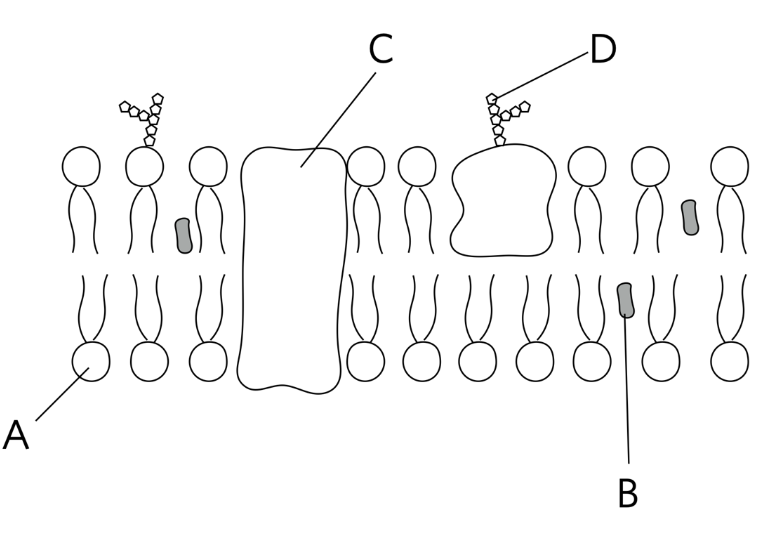
The drawing below represents a section through a plasma membrane.
Which of the following accurately names the structures in the drawing?
a) Structure B is a phospholipid and structure C is an integral protein
b) Structure C is a phospholipid and structure B is a peripheral protein.
c) Structure D is a fatty acid and structure C is a transmembrane protein.
d) Structure B is cholesterol and structure D is a carbohydrate.
d) Structure B is cholesterol and structure D is a carbohydrate.
Muscle cells require a large amount of oxygen, which they use in the process of aerobic cellular respiration to produce the ATP energy which the muscle cell requires when active. Oxygen is small and nonpolar.
It enters the muscle cell from the bloodstream by
a) osmosis
b) simple diffusion
c) facilitated diffusion
d) active transport
c) facilitated diffusion.
Because oxygen is very small and non-polar, so there’s nothing to stop it crossing membranes by simple diffusion.
Some students weighed a deshelled egg and placed it into a sucrose solution. After four hours, they removed the egg from the sucrose solution, carefully dried it and weighed it again. The egg weighed significantly less than it did previously.
From this information, it is reasonable to conclude that compared to the cytoplasm of the egg, the sucrose solution was:
a) exotonic
b) isotonic
c) hypertonic
d) hypotonic solution
c) hypertonic
Because the egg lost weight of course the weight that it lost will have been water that has moved out by osmosis and if water is moving out by osmosis that means that there must be a higher concentration of solutes outside the egg then inside. The concentration of water inside must be higher than the concentration of water outside.
For nerve cells to function, they must concentrate ions on either side of their plasma membrane, in order to establish an electrical potential across the membrane. One such ion is chloride which is concentrated on the inside of the neuron, making the cytoplasm electrically negative, relative to the extracellular fluid. In order for chloride ions to be brought into the neuron, the plasma membrane must:
a) use ATP.
b) move the ions through a channel protein.
c) decrease the concentration of chloride ions inside the neuron.
d) allow water to move out of the cell by osmosis.
a) use ATP
True or False: the mitochondria and chloroplasts are bound by a double membrane.
True.
How does the body use protein (amino acids)
Enzyme and hormone production, energy source, transport and storage and immune function.
How does the body use carbohydrates (mono, di, poly -saccarides)
mainly used for energy
Monosaccharides : Absorbed quickly for immediate energy. Glucose is used in cellular respiration to make ATP.
Polysaccharides (complex carbs, e.g., starch, glycogen, fiber) –
Starch: Slowly broken into glucose for longer energy release.
Glycogen: Stored in liver & muscles for later energy use.
Fiber: Aids digestion but isn't broken down for energy.
How does the body use lipids?
(Lipids are fats and oils) Insulation, protection and hormone production
Dendritic cells are white blood cells that play an important part in the immune system. When they encounter bacteria, they extend their cell membrane around the bacteria, enclosing them in a vacuole within the dendritic cell.
The action described above could be accurately called:
Either ‘endocytosis’ or ‘phagocytosis’.
Facilitated diffusion…
… requires the presence of a membrane protein.
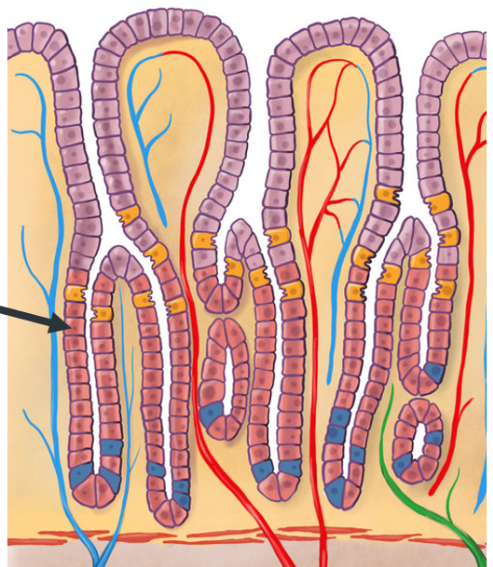
The drawing shows a section through the stomach wall. The lining of the intestine is at the top of the drawing. The dark red coloured cells (indicated with an arrow) are chief cells. They secrete the enzyme pepsin, which is responsible for digesting protein in the stomach.
Explain why there are many small chief cells, rather than just a few very large ones.
Small cells have a larger surface area to volume ratio than larger cells of the same shape. Since cells must exchange materials with their environment through the membrane, a larger surface area to volume ratio, therefore, increases the rate at which the chief cells in the stomach lining can pepsin.
After exercise, low levels of blood glucose can result in the release of glucagon (a hydrophilic protein hormone) from the pancreas. One site of glucagon activity is liver cells, where it causes a process called glycogenolysis to occur. In this process, stored glycogen is broken down and glucose is released into the blood stream.
Questions are next 3 cards.
Glucagon is a protein, much too large to cross a plasma membrane, even by active transport. Identify the process by which the cells of the pancreas can secrete such a large molecule. Describe this process.
Exocytosis. The glycogen proteins are enclosed in vesicles by the Golgi body. The vesicles move to the inside of the cell membrane, to which fuse, becoming part of the cell membrane, and releasing their contents into the extracellular fluid
When glycogenolysis occurs in a liver cell, the concentration of glucose in the cytosol increases. Glucose passes through the plasma membrane by facilitated diffusion. Describe how facilitated diffusion of glucose occurs.
The glucose enters a specific carrier protein (or transmembrane protein or channel protein1 which provides passive passage for the glucose through the membrane in the direction of its concentration gradient.
Glycogenolysis is necessary, because the liver does not store glucose as glucose, but converts it to glycogen, which is an insoluble polymer. Explain why it is an advantage to liver cells to store glucose as glycogen, rather than as glucose.
Glucose is soluble in water. If a liver cell stored a large amount of glucose, water would osmose into the cell, causing the liver cell to rupture. This is avoided by storing the glucose as an insoluble glycogen molecule.
Explain the Lock and Key model?
The model proposes that an enzyme's active site (the region where the substrate binds) has a rigid, specific shape that is perfectly complementary to the shape of its substrate. This "perfect fit" is analogous to a lock and its key. The Lock and Key model emphasizes the high specificity of enzymes.
Explain the induced fit model
Instead of a rigid "lock" (enzyme) and "key" (substrate), the induced fit model suggests that the enzyme's active site is more flexible. When a substrate approaches, it induces a conformational change (change in shape) in the enzyme, allowing the active site to mold itself around the substrate for a better fit.
Compare the two models.
The Lock and Key model is a good starting point for understanding enzyme-substrate interactions, but the Induced Fit model provides a more accurate and nuanced representation of the dynamic interplay between enzymes and substrates. The Induced Fit model accounts for the flexibility of enzymes and explains how they can optimize binding and catalysis.
Examples of an exergonic (catabolic) reaction include the formation of
fatty acids and glycerol from lipids.
Enzymes are
proteins that speed up chemical reactions.
Bacteria such as Thermus aquaticus live in hot springs where temperatures are around 90°C. The most likely reason that the bacteria are able to carry out their metabolic functions in this environment is that the bacteria…
have enzymes with a high optimal temperature.
Acetylcholinesterase is an enzyme that catalyses the breakdown of the neurotransmitter acetylcholine into acetate and choline.
Some chemicals used to kill insects contain aldicarb.
Aldicarb is a reversible inhibitor of acetylcholinesterase that…
reduces acetylcholinesterase activity by reducing the number of active sites for acetylcholine to bind to.
If the pH of the substrate solution is increased to 10, what do you expect would happen?
The rate of the reaction would decrease.
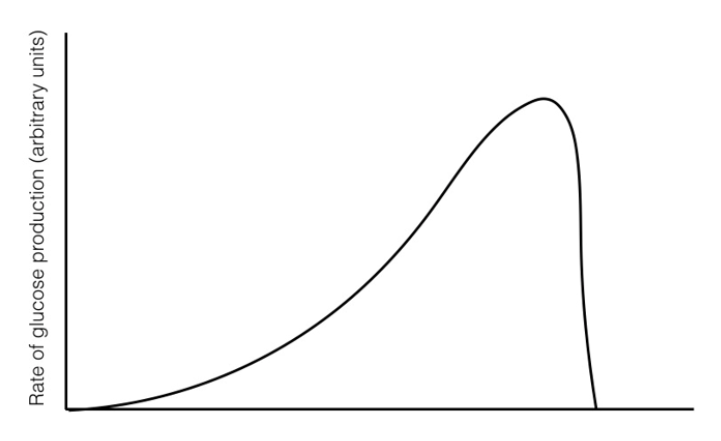
The enzyme glucosidase converts maltose to two glucose sugars. The graph shows the rate of a reaction catalysed by glycosidase.
The label on the horizontal axis is most likely to be…
temperature.
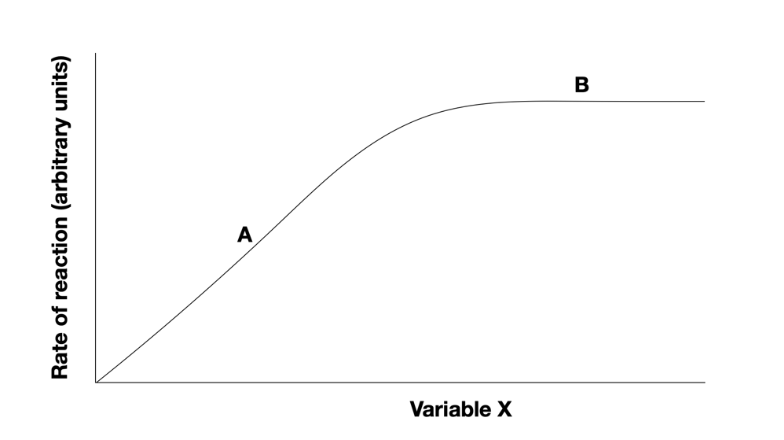
The graph depicts the relationship between the rate of an enzyme catalysed reaction and an independent variable (Variable X). The graph was drawn using data collected from an experiment conducted in a laboratory.
Variable X could be…
substrate concentration.
Enzymes don’t usually have an active site that is exactly complementary to the substrate’s binding site, but it is close enough that the substrate is attracted into the active site. Once the substrate enters the active site, the enzyme changes shape slightly, and this change in shape causes a change in the molecular bonds of the substrate.
The model which best describes this interaction between the enzyme and substrate is
the induced fit model.
State what an enzyme does
State the function of carbohydrates
State the function of proteins
What are some commonly regulated aspects of the internal environment?
Temperature
Oxygen concentration
carbon dioxide concentration
pH (acidity and alkalinity)
osmotic pressure
nitrogen waste concentration
glucose concentration
What is a phospholipid?
Phospholipids are lipids with a water-loving head and water-fearing tails. They form the basic structure of cell membranes, creating a barrier that controls what enters and exits the cell.
Glycoprotein definition
A molecule made up of proteins and sugar that protrudes on the outer surface of the membrane and plays a role in cell adhesion and recognition.
Define osmosis